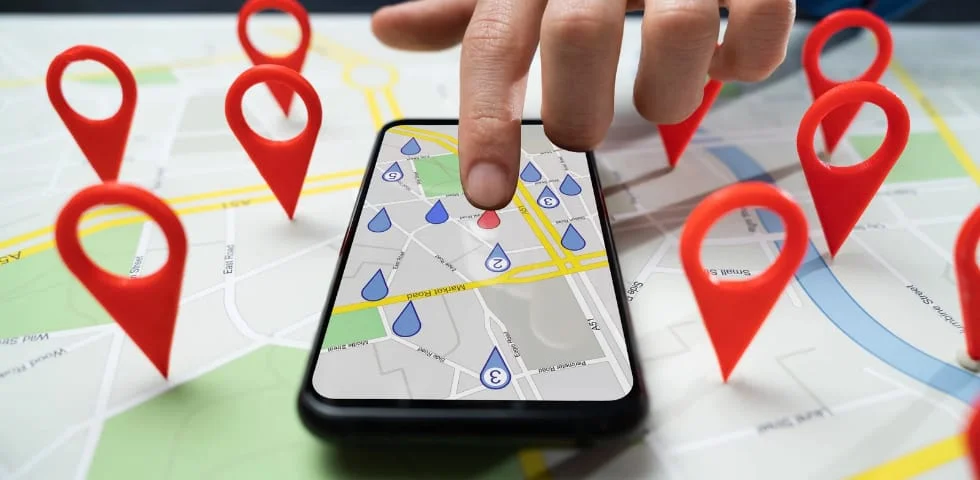Ever wondered why your competitors show up first on Google Maps while your business lingers on page two? If you’re running a local business, you’re likely searching for ways to boost your visibility and draw more customers to your doorstep. That’s where local SEO comes in. Local SEO is the secret sauce that can propel your business to the top of search results when customers are searching for services “near me.” In this guide, we’ll break down why local SEO is essential and provide you with actionable steps to master it, so you can stay ahead of the competition.
Why Local SEO is Crucial
Local SEO isn’t just another buzzword in the digital marketing world; it’s a game-changer, especially for small businesses. Here’s why:

The Surge in Local Searches
More and more people are searching for local businesses online. Terms like “coffee shops near me” or “plumbers in [your city]” are typed into search engines every day. In fact, studies show that nearly half of all Google searches have a local intent. If your business isn’t optimized for these searches, you’re missing out on potential customers who are ready to buy.
Boosting Foot Traffic and Online Visibility
For brick-and-mortar businesses, local SEO is a lifeline. A well-optimized local SEO strategy can put your business on the map—literally—by boosting your visibility on Google Maps and local search results. This means more foot traffic, more inquiries, and ultimately, more sales.
Leveling the Playing Field
Unlike traditional SEO, where big brands often dominate, local SEO offers a more level playing field. Even small businesses with limited budgets can compete with larger companies by focusing on local search optimization. By leveraging local SEO, you can carve out a niche in your community and become the go-to option for nearby customers.
Key Factors Influencing Local SEO Rankings
To truly master local SEO, it’s essential to understand the factors that influence your rankings in local search results. Here are the key elements you need to focus on:

Google My Business Optimization
Your Google My Business (GMB) profile is the cornerstone of local SEO. It’s often the first thing people see when searching for your business. Make sure your GMB profile is fully optimized—this includes updating your business name, address, and phone number (NAP), selecting the right categories, adding high-quality photos, and regularly posting updates. A well-maintained GMB profile can significantly improve your visibility in local search results.
NAP Consistency
NAP stands for Name, Address, and Phone Number, and consistency is key. Your NAP information should be identical across all online platforms—your website, social media profiles, and local directories. Inconsistent information can confuse search engines and potential customers, leading to lower rankings and lost business.
Local Reviews and Ratings
Online reviews are incredibly powerful. Not only do they influence potential customers, but they also impact your local search rankings. Encourage satisfied customers to leave positive reviews on your Google My Business profile and other review sites like Yelp. Responding to reviews, both positive and negative, shows that you value customer feedback and helps build trust.
Local Backlinks and Citations
Backlinks from reputable local websites and consistent citations (mentions of your business’s NAP) in online directories can boost your local SEO. Aim to get listed in local business directories and seek backlinks from local blogs, news sites, and industry-related websites. These backlinks and citations signal to search engines that your business is trustworthy and relevant within your local area.
Mobile Optimization and Local Search Behavior
With the increasing use of smartphones, mobile optimization is critical. Many local searches happen on mobile devices, so your website needs to be mobile-friendly. This means fast load times, easy navigation, and clear calls to action. Google prioritizes mobile-friendly websites, especially for local searches, so don’t overlook this aspect.
Step-by-Step Guide to Mastering Local SEO
Now that you know the key factors influencing local SEO, let’s dive into the steps you can take to optimize your business for local search success.

Set Up and Optimize Google My Business
- Claim Your Business: If you haven’t done so already, claim your Google My Business listing. This is the first step in getting your business visible on Google Maps and local search.
- Complete Your Profile: Fill out every section of your GMB profile—business name, address, phone number, website, hours of operation, and services. Add high-quality photos and a detailed business description that includes your primary keywords.
- Regular Updates: Keep your GMB profile fresh by posting updates, responding to reviews, and adding new photos regularly. This not only engages potential customers but also signals to Google that your business is active.
Ensure NAP Consistency Across All Platforms
- Audit Your Listings: Check all online platforms where your business is listed—social media profiles, business directories, and your own website. Make sure your NAP information is consistent across all these platforms.
- Use Tools: Consider using tools like Moz Local or BrightLocal to help identify and fix inconsistencies in your business listings. These tools can save you time and ensure accuracy.
Gather and Manage Local Reviews
- Ask for Reviews: Encourage happy customers to leave reviews on your GMB profile and other review sites. You can do this through follow-up emails, in-store signage, or social media.
- Respond to Reviews: Always respond to reviews, whether they’re positive or negative. Thank customers for their feedback and address any issues raised in negative reviews. This shows that you care about your customers and helps build your online reputation.
Build Local Citations and Backlinks
- List Your Business: Ensure your business is listed in relevant local directories like Yelp, Yellow Pages, and industry-specific directories. Consistent listings help improve your local search rankings.
- Seek Local Backlinks: Reach out to local bloggers, news sites, and industry-related websites to get backlinks. You can offer to write guest posts, collaborate on local events, or provide expert quotes to earn these valuable links.
Optimize Your Website for Local Search and Mobile Users
- Local Keywords: Include local keywords naturally in your website content—think city names, neighborhoods, and nearby landmarks. This helps Google understand your location and boosts your local rankings.
- Mobile-Friendly Design: Make sure your website is mobile-friendly. Test it on various devices to ensure fast load times, easy navigation, and clear CTAs. Google prioritizes mobile-optimized sites, especially for local searches.
- Create Local Content: Regularly publish blog posts or articles that are relevant to your local audience. Topics like local events, customer stories, or community involvement can help you connect with your audience and boost your local SEO.
Common Local SEO Mistakes to Avoid
Even with the best intentions, it’s easy to make mistakes that can hurt your local SEO efforts. Here are some common pitfalls and how to steer clear of them:

Ignoring Google My Business Updates
- Mistake: Once you’ve set up your Google My Business profile, it’s tempting to forget about it. However, Google frequently updates its features, and failing to keep your profile updated can result in missed opportunities.
- How to Avoid It: Regularly check your GMB profile for new features or updates. Take advantage of new tools, such as Google Posts or Q&A, to keep your profile active and engaging.
Inconsistent NAP Information
- Mistake: Inconsistent NAP information across different platforms can confuse both search engines and potential customers. This inconsistency can lead to lower search rankings and lost business.
- How to Avoid It: Conduct regular audits of your business listings across the web. Use a spreadsheet or a tool like Moz Local to track and maintain consistent NAP details everywhere your business is listed.
Neglecting Reviews or Responding Poorly
- Mistake: Ignoring customer reviews or responding in a defensive or negative manner can harm your reputation and local SEO. Reviews are a critical factor in local search rankings, and how you handle them matters.
- How to Avoid It: Actively manage your online reviews. Respond to all reviews—thank customers for positive feedback and address negative comments constructively. This shows potential customers that you value their opinions and helps build trust.
Overlooking Mobile Optimization
- Mistake: With the rise of mobile searches, a non-mobile-friendly website can significantly hurt your local SEO efforts. If your site isn’t optimized for mobile devices, you risk losing potential customers who are searching on the go.
- How to Avoid It: Ensure your website is fully optimized for mobile devices. Test your site’s responsiveness, speed, and usability on various smartphones and tablets. Prioritize a clean design, easy navigation, and quick load times.
Forgetting About Local Content Creation
- Mistake: Focusing solely on technical SEO elements and neglecting content creation can limit your local SEO success. Content is still king, especially when it comes to engaging your local audience.
- How to Avoid It: Regularly publish content that speaks to your local audience. This can include blog posts about local events, community involvement, or customer stories. Localized content not only engages readers but also signals to search engines that your business is relevant to the local area.
Next up, we’ll cover the Tools and Resources for Local SEO that can help you streamline your efforts.
Tools and Resources for Local SEO
To master local SEO, you don’t have to do it all on your own. There are plenty of tools and resources that can simplify the process and help you achieve better results. Here are some of the best:

Google My Business
- Why It’s Essential: Google My Business is a free tool from Google that helps you manage your online presence across Google, including Search and Maps. It’s crucial for getting your business seen in local search results.
- Key Features: Use it to update your business information, post updates, respond to reviews, and gain insights into how customers are finding and interacting with your business.
Moz Local
- Why It’s Helpful: Moz Local helps you manage your online listings and ensure that your NAP information is consistent across the web. It also helps you monitor and respond to reviews and check your local search rankings.
- Key Features: Automated listing updates, duplicate listing detection, and detailed reporting on your local SEO performance.
BrightLocal
- Why It’s Useful: BrightLocal is an all-in-one local SEO tool that provides insights into your local rankings, reviews, citations, and more. It’s great for businesses that want a comprehensive solution to manage their local SEO.
- Key Features: Local search rank tracking, citation tracking, review monitoring, and detailed local SEO reports.
SEMrush
- Why It’s Versatile: SEMrush is a powerful SEO tool that also offers features specifically designed for local SEO. It helps you track your local rankings, analyze competitors, and find local keyword opportunities.
- Key Features: Local keyword research, site audit, on-page SEO checker, and competitor analysis.
Whitespark
- Why It’s Effective: Whitespark offers a range of tools designed to improve your local search performance. It’s particularly well-known for its citation finder, which helps you discover and build new citations to boost your local rankings.
- Key Features: Local citation finder, review checker, and reputation builder.
Google Search Console
- Why It’s Crucial: Google Search Console is a free tool that gives you insight into how your website performs in Google search results. It helps you understand what keywords are driving traffic, how your pages are performing, and any issues that need fixing.
- Key Features: Performance reports, indexing status, and site performance monitoring.
These tools can save you time, improve your local SEO efforts, and provide valuable insights into your performance. By using them effectively, you can fine-tune your strategy and stay ahead in the competitive local search landscape.
Future Trends in Local SEO
Local SEO is constantly evolving, and staying ahead of the curve is essential for maintaining your competitive edge. Here are some emerging trends that are shaping the future of local search optimization:

Voice Search Optimization
- The Trend: As voice-activated devices like Amazon Alexa, Google Home, and Siri become more prevalent, voice search is on the rise. People are using voice commands to search for local businesses, often asking for directions, business hours, or specific services.
- How to Adapt: To optimize for voice search, focus on natural language keywords and phrases that people might use when speaking rather than typing. Ensure your business information is accurate and easily accessible, as voice search often pulls from sources like Google My Business.
The Rise of Zero-Click Searches
- The Trend: Zero-click searches are searches where the answer appears directly at the top of the search results, often in the form of a featured snippet, knowledge panel, or local pack. This means users get the information they need without ever clicking through to a website.
- How to Adapt: Optimize your content for featured snippets by answering common questions clearly and concisely in your content. Ensure your Google My Business profile is fully optimized, as this is often where zero-click information is pulled from.
The Growing Importance of Video Content
- The Trend: Video content is becoming increasingly important in local SEO. Consumers prefer watching videos about products and services before making purchasing decisions. Video also helps businesses engage with their audience and stand out in local search results.
- How to Adapt: Create short, engaging videos that showcase your products, services, and local community involvement. Share these videos on your website, social media, and Google My Business profile to boost your visibility.
Hyperlocal Targeting
- The Trend: As search engines become more sophisticated, they are increasingly focusing on hyperlocal results, showing users businesses that are not just in their city but in their immediate vicinity.
- How to Adapt: Optimize your content and Google My Business profile with specific neighborhood or district keywords. Engage with your local community by participating in local events and getting mentioned in local blogs or news outlets.
Personalization and AI in Local Search
- The Trend: Artificial intelligence and machine learning are playing a bigger role in how search engines deliver personalized search results. Local search results are becoming more tailored to individual users based on their behavior, preferences, and past searches.
- How to Adapt: Focus on delivering personalized experiences on your website and through your content. Use data from customer interactions to tailor your offerings and content to what your local audience is looking for.
By staying on top of these trends and adapting your strategy accordingly, you can ensure your business remains competitive in the local search landscape.
Conclusion
Local SEO is no longer optional—it’s essential for any business looking to attract and retain local customers. By understanding why local SEO matters and following the actionable steps outlined in this guide, you can unlock the full potential of your business in local search results. Remember, the landscape of local SEO is always changing, so keep an eye on emerging trends and be ready to adapt.














